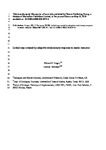Lethal trap created by adaptive evolutionary response to an exotic resource
| dc.contributor.author | Singer, Michael | |
| dc.contributor.author | Parmesan, Camille | |
| dc.date.accessioned | 2018-05-26T00:02:16Z | |
| dc.date.issued | 2018-05-10 | |
| dc.identifier.issn | 0028-0836 | |
| dc.identifier.issn | 1476-4687 | |
| dc.identifier.uri | http://hdl.handle.net/10026.1/11598 | |
| dc.description.abstract |
Global transport of organisms by humans provides novel resources to wild species, which often respond maladaptively. Native herbivorous insects have been killed feeding on toxic exotic plants, which acted as ‘ecological traps’1,2,3,4. We document a novel ‘eco-evolutionary trap’ stemming from the opposite effect; that is, high fitness on an exotic resource despite lack of adaptation to it. Plantago lanceolata was introduced to western North America by cattle-ranching. Feeding on this exotic plant released a large, isolated population of the native butterfly Euphydryas editha from a longstanding trade-off between maternal fecundity and offspring mortality. Because of this release—and despite a reduced insect developmental rate when feeding on this exotic—Plantago immediately supported higher larval survival than did the insects’ traditional host, Collinsia parviflora5. Previous work from the 1980s documented an evolving preference for Plantago by ovipositing adults6. We predicted that if this trend continued the insects could endanger themselves, because the availability of Plantago to butterflies is controlled by humans, who change land management practices faster than butterflies evolve6. Here we report the fulfilment of this prediction. The butterflies abandoned Collinsia and evolved total dependence on Plantago. The trap was set. In 2005, humans withdrew their cattle, springing the trap. Grasses grew around the Plantago, cooling the thermophilic insects, which then went extinct. This local extinction could have been prevented if the population had retained partial use of Collinsia, which occupied drier microhabitats unaffected by cattle removal. The flush of grasses abated quickly, rendering the meadow once again suitable for Euphydryas feeding on either host, but no butterflies were observed from 2008 to 2012. In 2013–2014, the site was naturally recolonized by Euphydryas feeding exclusively on Collinsia, returning the system to its starting point and setting the stage for a repeat of the anthropogenic evolutionary cycle. | |
| dc.format.extent | 238-+ | |
| dc.format.medium | Print-Electronic | |
| dc.language | en | |
| dc.language.iso | en | |
| dc.publisher | Nature Publishing Group | |
| dc.rights | Attribution-NonCommercial-NoDerivatives 4.0 International | |
| dc.rights | Attribution-NonCommercial-NoDerivatives 4.0 International | |
| dc.rights | Attribution-NonCommercial-NoDerivatives 4.0 International | |
| dc.rights | Attribution-NonCommercial-NoDerivatives 4.0 International | |
| dc.rights | Attribution-NonCommercial-NoDerivatives 4.0 International | |
| dc.rights.uri | http://creativecommons.org/licenses/by-nc-nd/4.0/ | |
| dc.rights.uri | http://creativecommons.org/licenses/by-nc-nd/4.0/ | |
| dc.rights.uri | http://creativecommons.org/licenses/by-nc-nd/4.0/ | |
| dc.rights.uri | http://creativecommons.org/licenses/by-nc-nd/4.0/ | |
| dc.rights.uri | http://creativecommons.org/licenses/by-nc-nd/4.0/ | |
| dc.subject | Adaptation, Physiological | |
| dc.subject | Animals | |
| dc.subject | Biological Evolution | |
| dc.subject | Butterflies | |
| dc.subject | Cattle | |
| dc.subject | Domestication | |
| dc.subject | Extinction, Biological | |
| dc.subject | Female | |
| dc.subject | Herbivory | |
| dc.subject | Human Activities | |
| dc.subject | Larva | |
| dc.subject | North America | |
| dc.subject | Oviposition | |
| dc.subject | Plantago | |
| dc.subject | Poaceae | |
| dc.title | Lethal trap created by adaptive evolutionary response to an exotic resource | |
| dc.type | journal-article | |
| dc.type | Journal Article | |
| plymouth.author-url | http://gateway.webofknowledge.com/gateway/Gateway.cgi?GWVersion=2&SrcApp=PARTNER_APP&SrcAuth=LinksAMR&KeyUT=WOS:000431775100049&DestLinkType=FullRecord&DestApp=ALL_WOS&UsrCustomerID=11bb513d99f797142bcfeffcc58ea008 | |
| plymouth.issue | 7704 | |
| plymouth.volume | 557 | |
| plymouth.publication-status | Published | |
| plymouth.journal | Nature | |
| dc.identifier.doi | 10.1038/s41586-018-0074-6 | |
| plymouth.organisational-group | /Plymouth | |
| plymouth.organisational-group | /Plymouth/Faculty of Science and Engineering | |
| plymouth.organisational-group | /Plymouth/REF 2021 Researchers by UoA | |
| plymouth.organisational-group | /Plymouth/REF 2021 Researchers by UoA/UoA07 Earth Systems and Environmental Sciences | |
| dc.publisher.place | England | |
| dcterms.dateAccepted | 2018-03-24 | |
| dc.rights.embargodate | 2018-11-9 | |
| dc.identifier.eissn | 1476-4687 | |
| dc.rights.embargoperiod | 6 months | |
| rioxxterms.versionofrecord | 10.1038/s41586-018-0074-6 | |
| rioxxterms.licenseref.uri | http://creativecommons.org/licenses/by-nc-nd/4.0/ | |
| rioxxterms.licenseref.startdate | 2018-05-10 | |
| rioxxterms.type | Journal Article/Review |



